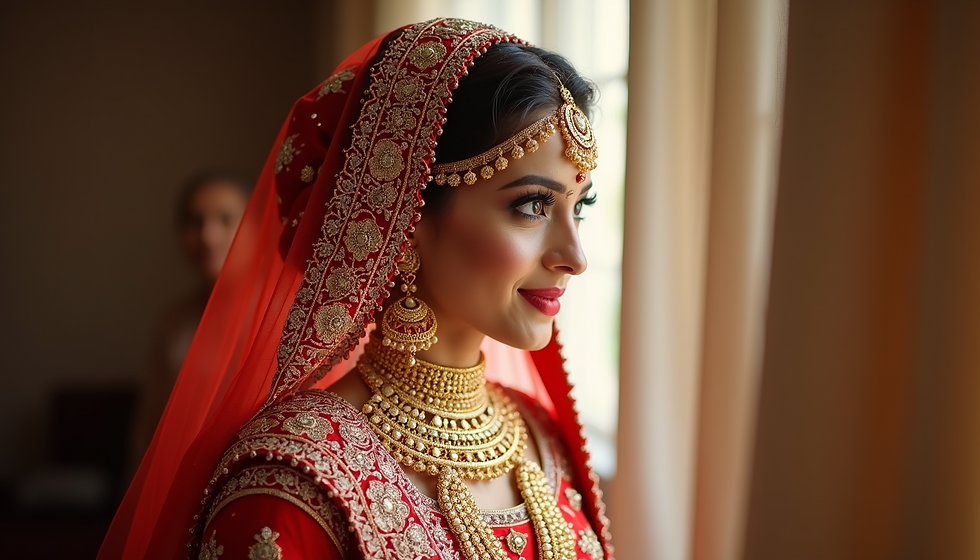Gharara vs Sharara: What, Where, When
- Harpreet
- Jun 23
- 3 min read
Updated: Sep 9
What's the Difference Between a Gharara and Sharara Outfit? When to Choose Between Them
When planning your perfect Punjabi wedding outfit, one common question arises: What’s the difference between a Gharara and a Sharara? These two traditional ensembles are often confused. However, each has its distinct style, history, and charm.
In this guide, we’ll break down the key differences between a Gharara and a Sharara. By understanding them, you can choose the right outfit for your big day or special occasion.
What is a Gharara?
A Gharara is a traditional Mughal-era outfit. It is primarily worn in North India and Pakistan, especially by Muslim brides, but has become popular among Punjabis too. It consists of three parts:

A short kurti (tunic)
A wide-legged pant with a fitted knee (called gota or knee band), which flares out dramatically below
A dupatta (scarf)
The Gharara’s distinctive feature is its stitched knee, which creates a voluminous flare below. This characteristic gives the Gharara its iconic royal look. It is often enhanced with zari, zardozi, or gota patti work. Ghararas are staples at traditional Punjabi weddings, especially during mehndi and sangeet ceremonies.
What is a Sharara?

Contrarily, a Sharara is also a traditional three-piece outfit, but with one key difference—it does not have a stitched knee. Instead, the pants of a Sharara are wide-legged from the waist down. They flow straight like a maxi skirt but are split into two legs. A Sharara is paired with either a long or short kurti and a dupatta.
The fluid and comfortable design of Sharara sets makes them a preferred choice for pre-wedding events, receptions, or even bridesmaids’ outfits at a Punjabi wedding.
Gharara vs Sharara: Key Differences
Feature | Gharara | Sharara |
Knee Design | Stitched knee with flare below | No stitching; flares from waist |
Look & Feel | Structured, formal, regal | Flowing, relaxed, elegant |
Occasion | Bridal wear, formal events | Pre-wedding, semi-formal functions |
Origin | Mughal, Lucknowi influence | Middle Eastern, Indo-Pak fusion |
Styling | Heavy embellishments, rich fabrics | Lightweight, modern embroidery |
Gharara & Sharara in Punjabi Weddings
Though both outfits are traditional, Punjabi weddings are known for their bold colors and intricate embroidery. For the main ceremony, brides often choose Ghararas due to their grandeur. Conversely, Shararas are favored for mehendi and haldi events because of their easy movements and elegant silhouettes.
Modern designers have also blended these outfits with contemporary styles. This fusion makes them must-haves in a Punjabi bridal trousseau.
Styling Tips for Ghararas & Shararas
Ghararas pair beautifully with short embellished kurtis and heavily embroidered dupattas. Fabrics with heavy borders work best for Gharara bottoms.
Shararas look stunning with asymmetrical or peplum-style tops. Fabrics featuring all-over embroidery create beautiful sharara outfits.
Enhance your Punjabi wedding outfit with traditional jewelry, such as jhumkas, maang tikka, and kaleere.
Experiment with pastel tones or bold jewel shades like maroon, emerald, and navy to make a statement.
When to Choose Gharara or Sharara
When deciding between a Gharara and a Sharara for your event, consider the ambiance and your personal style. If you seek a structured, royal look, the Gharara is an excellent choice. For something more flowy and modern, opt for a Sharara.
Final Thoughts: Which One Should You Choose?
Both Ghararas and Shararas are timeless, deeply rooted in South Asian heritage, and perfect for enhancing your look at any Punjabi wedding. Choosing between the two ultimately depends on what suits your style and the event.
Harpreet Kaur (Maker of Apna Clothing)

"I remember the first time I wore a Gharara suit. I found the tightness around my knees very uncomfortable and decided that I'm a Sharara girl! But the more I would see Gharara outfits, the more I understood their appeal. I decided to give Gharara outfits another go but with more space around my knee, which was perfect! To me, it’s always important to find outfits that are comfortable so you can focus on enjoying the celebration! In the end though, I seem to always go back to the Sharara!
For an exquisite collection, check out Unstitched Suit with Mirrorwork.
Adopt the style that resonates with you and seize the moments of joy during your wedding festivities!




Comments